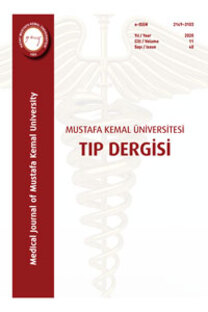VASO-OKLUSİV KRİZ ORAK HÜCRELİ ANEMİDE HEMATOLOJİK PARAMETRELERİ NASIL DEĞİŞTİRİR?
Orak hücreli anemili, vazooklüziv kriz, hematolojik parametre
How Does Vaso-occlusive Crisis Alter Hematological Parameters in Sickle Cell Anemia?
___
- Patel DK, Mohapatra MK, Thomas AG, Patel S, Purohit P. Procalcitonin as a biomarker of
- bacterial infection in sickle cell vaso-occlusive crisis. Mediterr J Hematol Infect
- Dis. 2014;6(1):e2014018.
- Koren A, Wald I, Halevi R, Ben Ami M. Acute chest syndrome in children with sickle cell
- anemia. Pediatr Hematol Oncol. 1990;7(1):99-107.
- Ahmed SG. The role of infection in the pathogenesis of vaso-occlusive crisis in patients
- with sickle cell disease. Mediterr J Hematol Infect Dis. 2011;3(1):e2011028.
- Valavi E, Ansari MJ, Zandian K. How to reach rapid diagnosis in sickle cell disease? Iran J
- Pediatr. 2010;20(1):69-74.
- Antmen B. Orak hücre anemisi. Türk Ped Arş 2009; 44: 39-42.
- Akohoue SA, Shankar S, Milne GL, Morrow J, Chen KY, Ajayi WU, Buchowski MS. Energy
- expenditure, inflammation, and oxidative stress in steady-state adolescents with sickle cell anemia.
- Pediatr Res. 2007;61(2):233-8.
- Emmanuelchide O, Charle O, Uchenna O. Hematological parameters in association with
- outcomes in sickle cell anemia patients. Indian J Med Sci. 2011;65(9):393-8.
- Schimmel M, Nur E, Biemond BJ, van Mierlo GJ, Solati S, Brandjes DP, Otten HM, Schnog
- JJ, Zeerleder S; Curama Study Group. Nucleosomes and neutrophil activation in sickle cell
- disease painful crisis. Haematologica. 2013;98(11):1797-803.
- Akinbami A, Dosunmu A, Adediran A, Oshinaike O, Adebola P, Arogundade O.
- Haematological values in homozygous sickle cell disease in steady state and haemoglobin phenotypes
- AA controls in Lagos, Nigeria. BMC Res Notes. 2012 1;5:396.
- Walke VA, Walde MS. Haematological study in sickle cell homozygous and heterozygous
- children in the age group 0-6 years. Indian J Pathol Microbiol. 2007 ;50(4):901-4.
- el Sayed HL, Tawfik ZM. Red cell profile in normal and sickle cell diseased children. J Egypt
- Soc Parasitol. 1994;24(1):147-54.
- Mohan JS, Lip GY, Bareford D, Blann AD. Platelet P-selectin and platelet mass, volume and
- component in sickle cell disease: relationship to genotype. Thromb Res. 2006;117(6):623-9.
- ISSN: 2149-3103
- Yayın Aralığı: 3
- Başlangıç: 2010
- Yayıncı: Hatay Mustafa Kemal Üniversitesi Tıp Fakültesi Dekanlığı
S. BAŞARSLAN, Cüneyt GÖÇMEZ, Kağan KAMAŞAK
FAHR HASTALIĞI: BEŞ OLGU SUNUMU
İsmail KARTAL, Musa ŞAHPOLAT, M. KOKAÇYA, Nesrin ATÇI
VASO-OKLUSİV KRİZ ORAK HÜCRELİ ANEMİDE HEMATOLOJİK PARAMETRELERİ NASIL DEĞİŞTİRİR?
Can ACIPAYAM, Sadık KAYA, Gönül OKTAY, Gül İLHAN
ÇOCUKLARDA SUDA BOĞULMALARA GÜNCEL YAKLAŞIMLAR
Vefik ARICA, Hüseyin DAĞ, Sibel KALÇIN, Sevilay KÖK, Kübra BÖLÜK, Murat DOĞAN
